Human Resource Management Practices
VerifiedAdded on 2020/01/23
|16
|5276
|104
Essay
AI Summary
This assignment delves into contemporary Human Resource Management (HRM) practices. It examines the crucial aspects of managing diversity within organizations, the significance of human capital as a resource, and the evolving landscape of workplace flexibility. The analysis draws upon scholarly sources to provide insights into effective HRM strategies and their impact on organizational success.
Contribute Materials
Your contribution can guide someone’s learning journey. Share your
documents today.
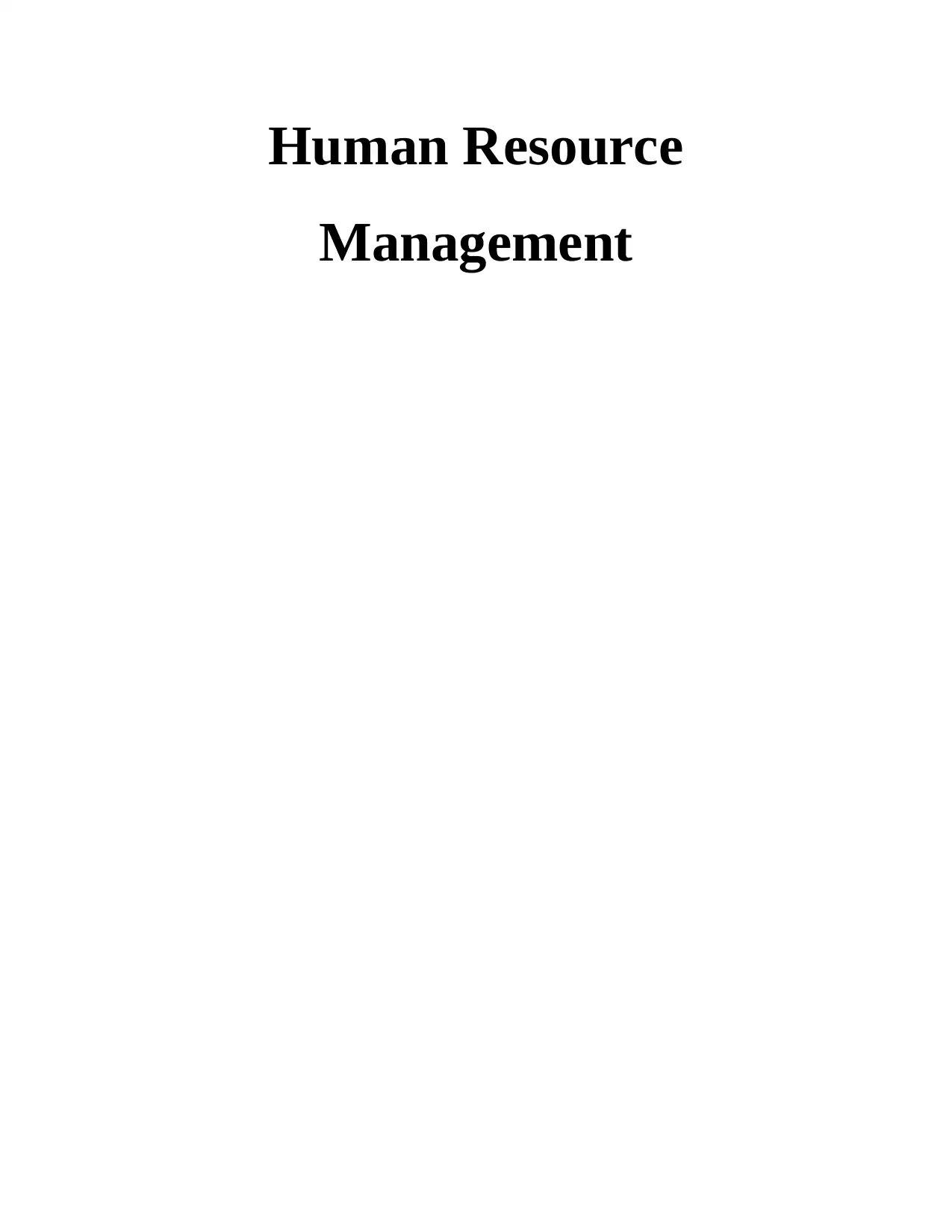
Human Resource
Management
Management
Secure Best Marks with AI Grader
Need help grading? Try our AI Grader for instant feedback on your assignments.

TABLE OF CONTENT
INTRODUCTION...........................................................................................................................1
TASK 1............................................................................................................................................1
1.1................................................................................................................................................1
1.2................................................................................................................................................3
1.3................................................................................................................................................4
1.4................................................................................................................................................5
TASK 2............................................................................................................................................5
2.1................................................................................................................................................5
2.2................................................................................................................................................6
2.3................................................................................................................................................7
2.4................................................................................................................................................8
TASK 3............................................................................................................................................8
3.1................................................................................................................................................8
3.2................................................................................................................................................9
3.3................................................................................................................................................9
3.4................................................................................................................................................9
TASK 4..........................................................................................................................................10
4.1..............................................................................................................................................10
4.2..............................................................................................................................................11
4.3..............................................................................................................................................11
CONCLUSION..............................................................................................................................12
REFERENCES..............................................................................................................................13
INTRODUCTION...........................................................................................................................1
TASK 1............................................................................................................................................1
1.1................................................................................................................................................1
1.2................................................................................................................................................3
1.3................................................................................................................................................4
1.4................................................................................................................................................5
TASK 2............................................................................................................................................5
2.1................................................................................................................................................5
2.2................................................................................................................................................6
2.3................................................................................................................................................7
2.4................................................................................................................................................8
TASK 3............................................................................................................................................8
3.1................................................................................................................................................8
3.2................................................................................................................................................9
3.3................................................................................................................................................9
3.4................................................................................................................................................9
TASK 4..........................................................................................................................................10
4.1..............................................................................................................................................10
4.2..............................................................................................................................................11
4.3..............................................................................................................................................11
CONCLUSION..............................................................................................................................12
REFERENCES..............................................................................................................................13
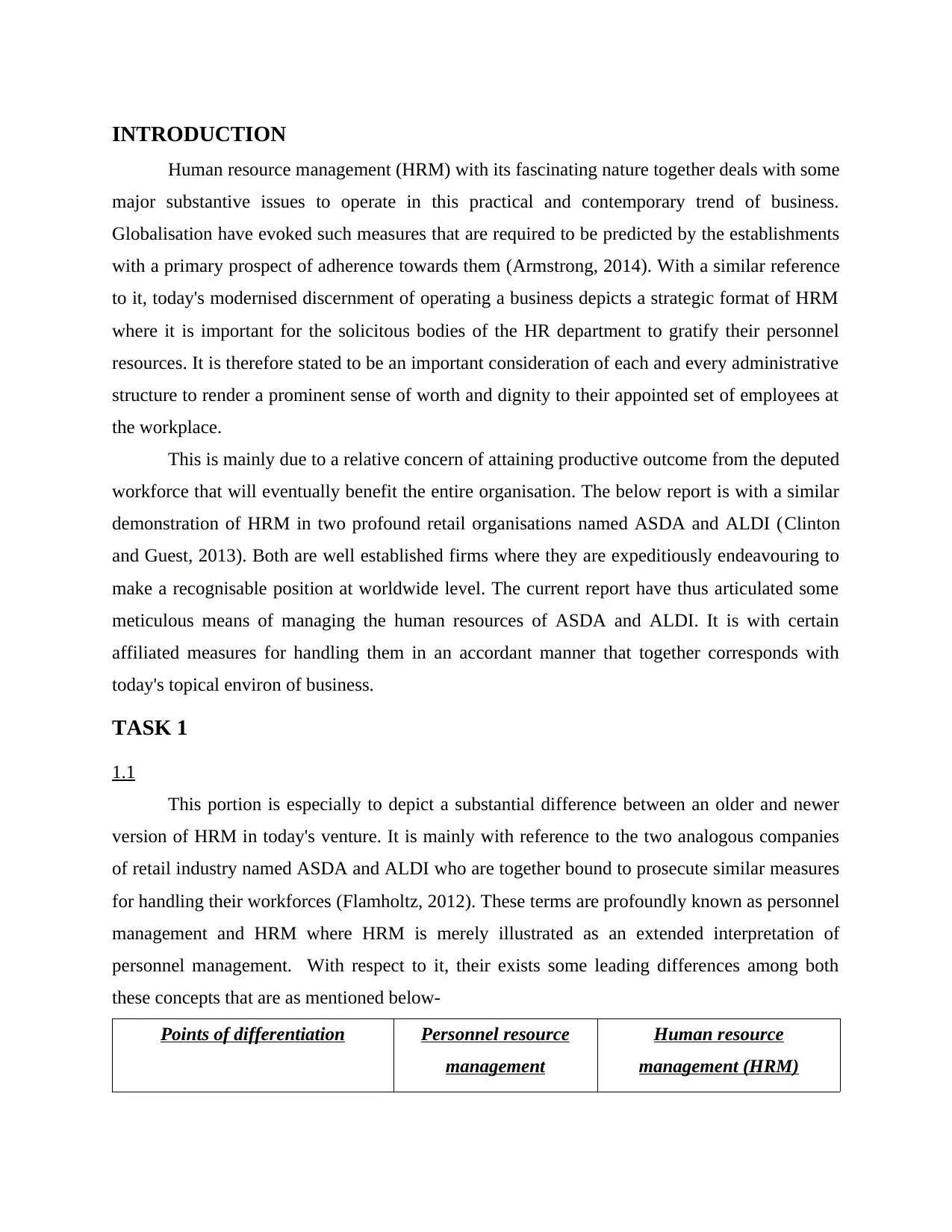
INTRODUCTION
Human resource management (HRM) with its fascinating nature together deals with some
major substantive issues to operate in this practical and contemporary trend of business.
Globalisation have evoked such measures that are required to be predicted by the establishments
with a primary prospect of adherence towards them (Armstrong, 2014). With a similar reference
to it, today's modernised discernment of operating a business depicts a strategic format of HRM
where it is important for the solicitous bodies of the HR department to gratify their personnel
resources. It is therefore stated to be an important consideration of each and every administrative
structure to render a prominent sense of worth and dignity to their appointed set of employees at
the workplace.
This is mainly due to a relative concern of attaining productive outcome from the deputed
workforce that will eventually benefit the entire organisation. The below report is with a similar
demonstration of HRM in two profound retail organisations named ASDA and ALDI (Clinton
and Guest, 2013). Both are well established firms where they are expeditiously endeavouring to
make a recognisable position at worldwide level. The current report have thus articulated some
meticulous means of managing the human resources of ASDA and ALDI. It is with certain
affiliated measures for handling them in an accordant manner that together corresponds with
today's topical environ of business.
TASK 1
1.1
This portion is especially to depict a substantial difference between an older and newer
version of HRM in today's venture. It is mainly with reference to the two analogous companies
of retail industry named ASDA and ALDI who are together bound to prosecute similar measures
for handling their workforces (Flamholtz, 2012). These terms are profoundly known as personnel
management and HRM where HRM is merely illustrated as an extended interpretation of
personnel management. With respect to it, their exists some leading differences among both
these concepts that are as mentioned below-
Points of differentiation Personnel resource
management
Human resource
management (HRM)
Human resource management (HRM) with its fascinating nature together deals with some
major substantive issues to operate in this practical and contemporary trend of business.
Globalisation have evoked such measures that are required to be predicted by the establishments
with a primary prospect of adherence towards them (Armstrong, 2014). With a similar reference
to it, today's modernised discernment of operating a business depicts a strategic format of HRM
where it is important for the solicitous bodies of the HR department to gratify their personnel
resources. It is therefore stated to be an important consideration of each and every administrative
structure to render a prominent sense of worth and dignity to their appointed set of employees at
the workplace.
This is mainly due to a relative concern of attaining productive outcome from the deputed
workforce that will eventually benefit the entire organisation. The below report is with a similar
demonstration of HRM in two profound retail organisations named ASDA and ALDI (Clinton
and Guest, 2013). Both are well established firms where they are expeditiously endeavouring to
make a recognisable position at worldwide level. The current report have thus articulated some
meticulous means of managing the human resources of ASDA and ALDI. It is with certain
affiliated measures for handling them in an accordant manner that together corresponds with
today's topical environ of business.
TASK 1
1.1
This portion is especially to depict a substantial difference between an older and newer
version of HRM in today's venture. It is mainly with reference to the two analogous companies
of retail industry named ASDA and ALDI who are together bound to prosecute similar measures
for handling their workforces (Flamholtz, 2012). These terms are profoundly known as personnel
management and HRM where HRM is merely illustrated as an extended interpretation of
personnel management. With respect to it, their exists some leading differences among both
these concepts that are as mentioned below-
Points of differentiation Personnel resource
management
Human resource
management (HRM)
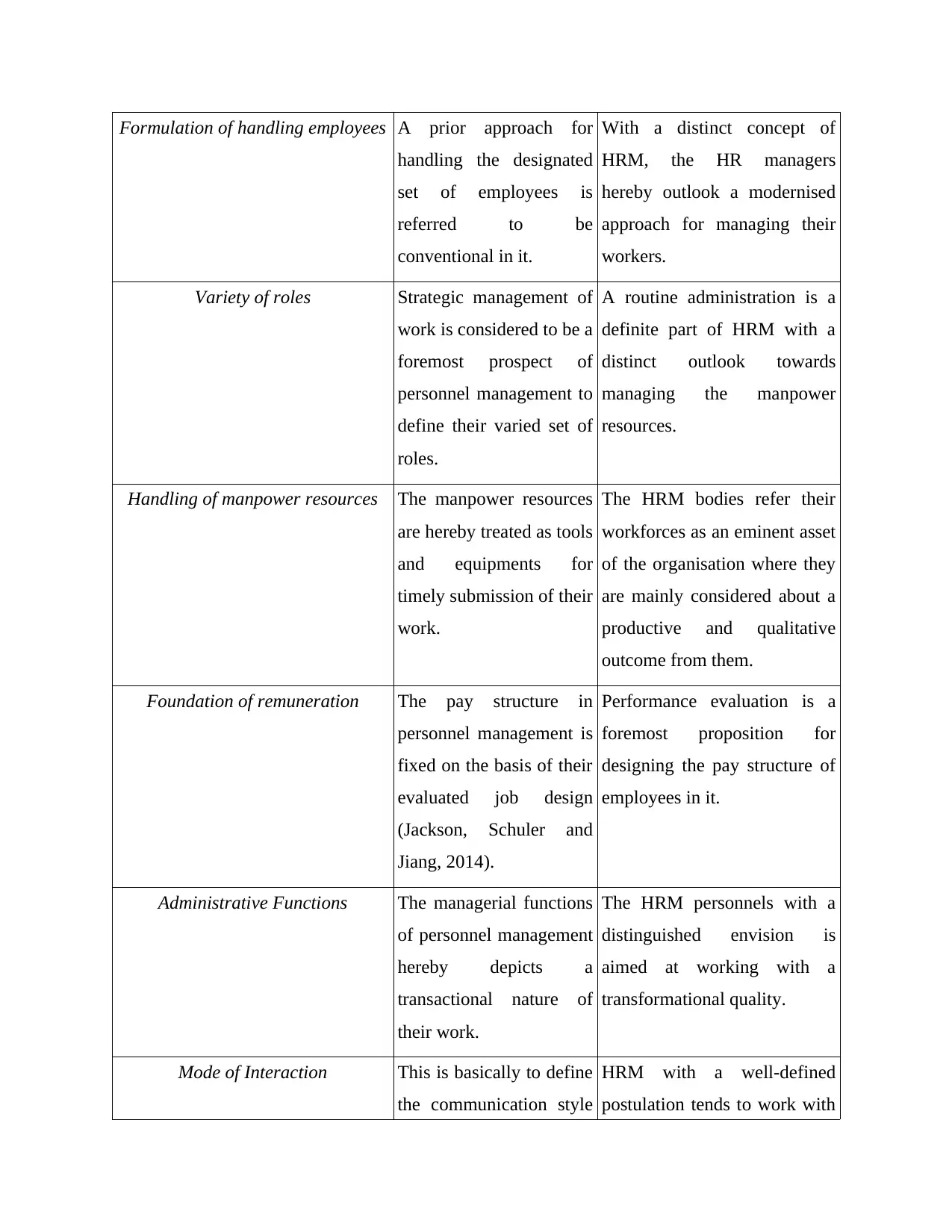
Formulation of handling employees A prior approach for
handling the designated
set of employees is
referred to be
conventional in it.
With a distinct concept of
HRM, the HR managers
hereby outlook a modernised
approach for managing their
workers.
Variety of roles Strategic management of
work is considered to be a
foremost prospect of
personnel management to
define their varied set of
roles.
A routine administration is a
definite part of HRM with a
distinct outlook towards
managing the manpower
resources.
Handling of manpower resources The manpower resources
are hereby treated as tools
and equipments for
timely submission of their
work.
The HRM bodies refer their
workforces as an eminent asset
of the organisation where they
are mainly considered about a
productive and qualitative
outcome from them.
Foundation of remuneration The pay structure in
personnel management is
fixed on the basis of their
evaluated job design
(Jackson, Schuler and
Jiang, 2014).
Performance evaluation is a
foremost proposition for
designing the pay structure of
employees in it.
Administrative Functions The managerial functions
of personnel management
hereby depicts a
transactional nature of
their work.
The HRM personnels with a
distinguished envision is
aimed at working with a
transformational quality.
Mode of Interaction This is basically to define
the communication style
HRM with a well-defined
postulation tends to work with
handling the designated
set of employees is
referred to be
conventional in it.
With a distinct concept of
HRM, the HR managers
hereby outlook a modernised
approach for managing their
workers.
Variety of roles Strategic management of
work is considered to be a
foremost prospect of
personnel management to
define their varied set of
roles.
A routine administration is a
definite part of HRM with a
distinct outlook towards
managing the manpower
resources.
Handling of manpower resources The manpower resources
are hereby treated as tools
and equipments for
timely submission of their
work.
The HRM bodies refer their
workforces as an eminent asset
of the organisation where they
are mainly considered about a
productive and qualitative
outcome from them.
Foundation of remuneration The pay structure in
personnel management is
fixed on the basis of their
evaluated job design
(Jackson, Schuler and
Jiang, 2014).
Performance evaluation is a
foremost proposition for
designing the pay structure of
employees in it.
Administrative Functions The managerial functions
of personnel management
hereby depicts a
transactional nature of
their work.
The HRM personnels with a
distinguished envision is
aimed at working with a
transformational quality.
Mode of Interaction This is basically to define
the communication style
HRM with a well-defined
postulation tends to work with
Paraphrase This Document
Need a fresh take? Get an instant paraphrase of this document with our AI Paraphraser
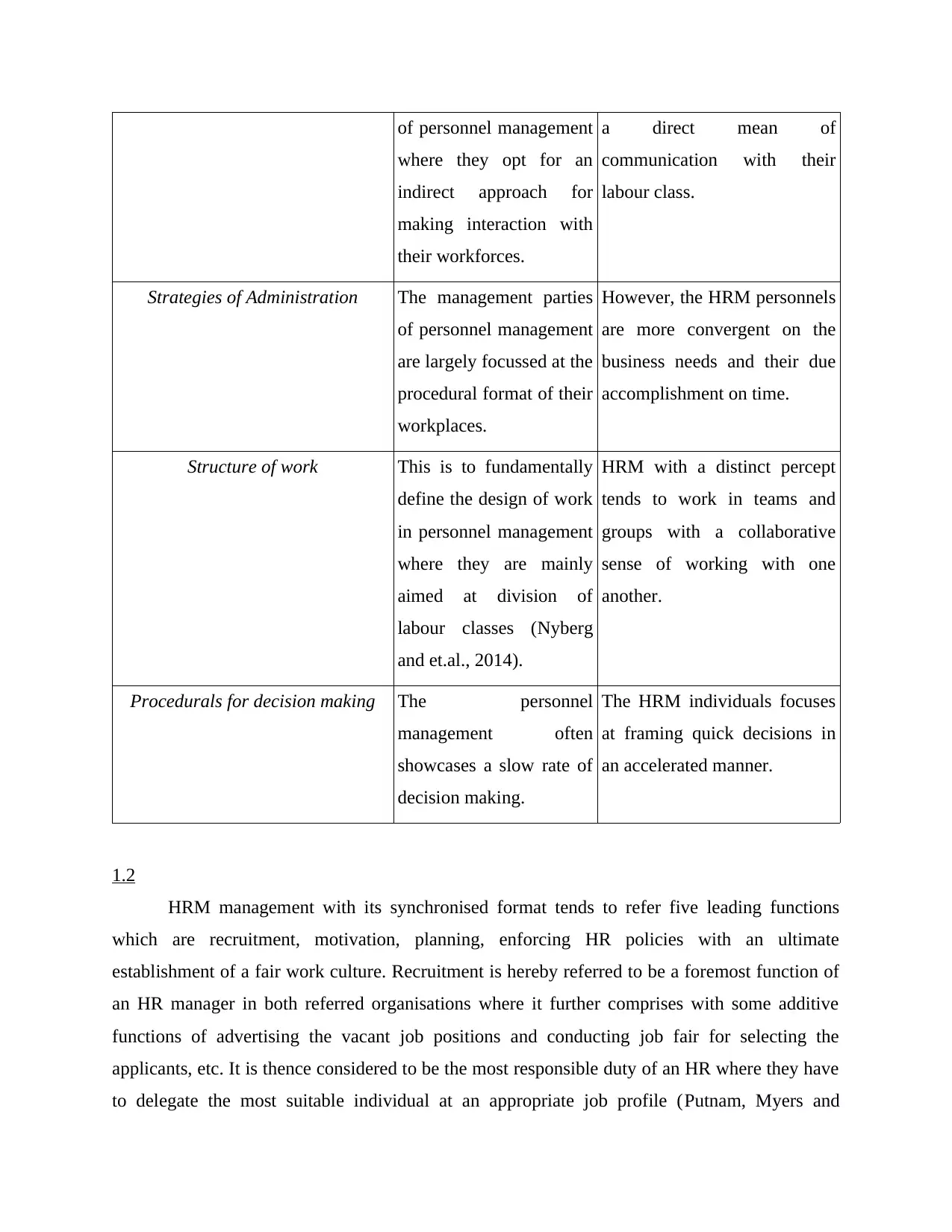
of personnel management
where they opt for an
indirect approach for
making interaction with
their workforces.
a direct mean of
communication with their
labour class.
Strategies of Administration The management parties
of personnel management
are largely focussed at the
procedural format of their
workplaces.
However, the HRM personnels
are more convergent on the
business needs and their due
accomplishment on time.
Structure of work This is to fundamentally
define the design of work
in personnel management
where they are mainly
aimed at division of
labour classes (Nyberg
and et.al., 2014).
HRM with a distinct percept
tends to work in teams and
groups with a collaborative
sense of working with one
another.
Procedurals for decision making The personnel
management often
showcases a slow rate of
decision making.
The HRM individuals focuses
at framing quick decisions in
an accelerated manner.
1.2
HRM management with its synchronised format tends to refer five leading functions
which are recruitment, motivation, planning, enforcing HR policies with an ultimate
establishment of a fair work culture. Recruitment is hereby referred to be a foremost function of
an HR manager in both referred organisations where it further comprises with some additive
functions of advertising the vacant job positions and conducting job fair for selecting the
applicants, etc. It is thence considered to be the most responsible duty of an HR where they have
to delegate the most suitable individual at an appropriate job profile (Putnam, Myers and
where they opt for an
indirect approach for
making interaction with
their workforces.
a direct mean of
communication with their
labour class.
Strategies of Administration The management parties
of personnel management
are largely focussed at the
procedural format of their
workplaces.
However, the HRM personnels
are more convergent on the
business needs and their due
accomplishment on time.
Structure of work This is to fundamentally
define the design of work
in personnel management
where they are mainly
aimed at division of
labour classes (Nyberg
and et.al., 2014).
HRM with a distinct percept
tends to work in teams and
groups with a collaborative
sense of working with one
another.
Procedurals for decision making The personnel
management often
showcases a slow rate of
decision making.
The HRM individuals focuses
at framing quick decisions in
an accelerated manner.
1.2
HRM management with its synchronised format tends to refer five leading functions
which are recruitment, motivation, planning, enforcing HR policies with an ultimate
establishment of a fair work culture. Recruitment is hereby referred to be a foremost function of
an HR manager in both referred organisations where it further comprises with some additive
functions of advertising the vacant job positions and conducting job fair for selecting the
applicants, etc. It is thence considered to be the most responsible duty of an HR where they have
to delegate the most suitable individual at an appropriate job profile (Putnam, Myers and
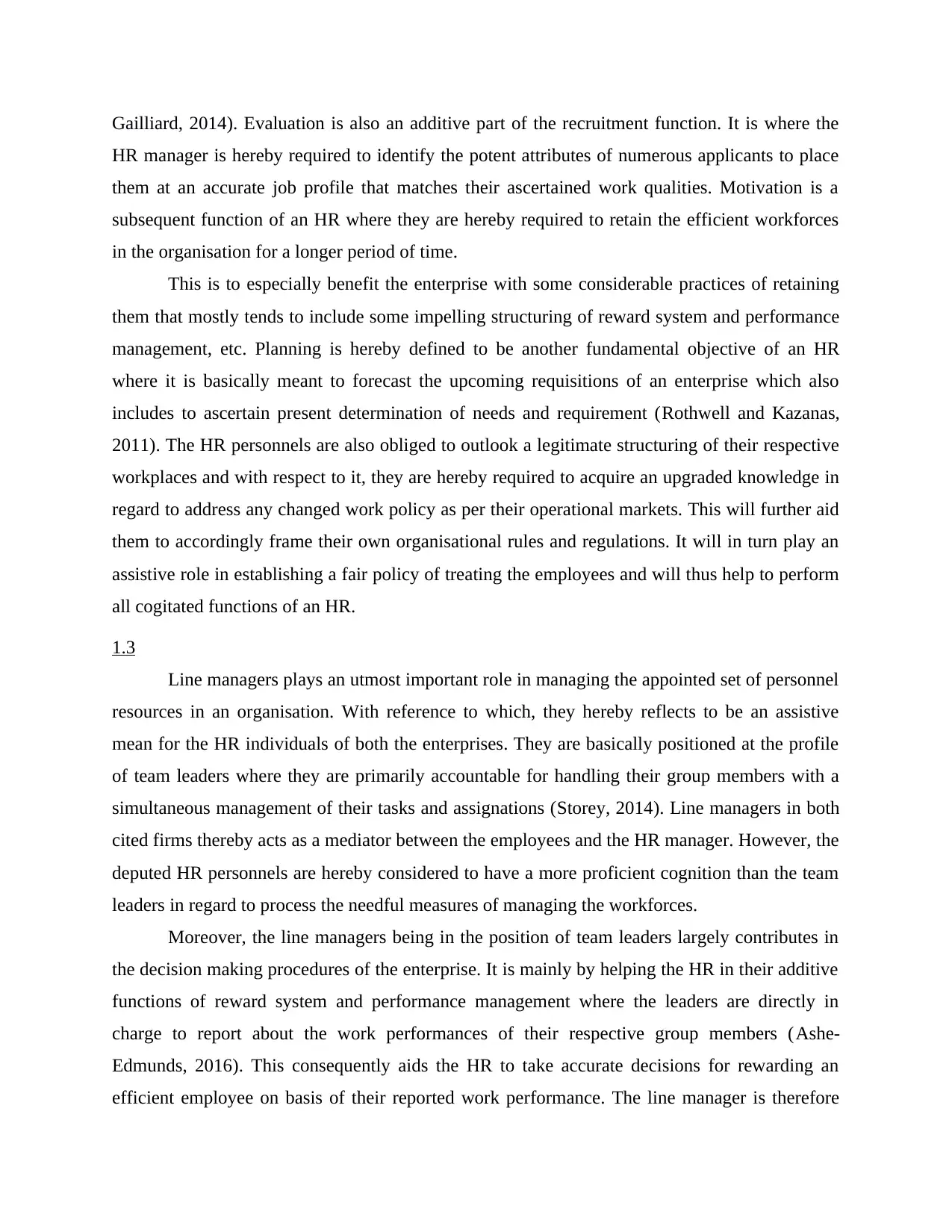
Gailliard, 2014). Evaluation is also an additive part of the recruitment function. It is where the
HR manager is hereby required to identify the potent attributes of numerous applicants to place
them at an accurate job profile that matches their ascertained work qualities. Motivation is a
subsequent function of an HR where they are hereby required to retain the efficient workforces
in the organisation for a longer period of time.
This is to especially benefit the enterprise with some considerable practices of retaining
them that mostly tends to include some impelling structuring of reward system and performance
management, etc. Planning is hereby defined to be another fundamental objective of an HR
where it is basically meant to forecast the upcoming requisitions of an enterprise which also
includes to ascertain present determination of needs and requirement (Rothwell and Kazanas,
2011). The HR personnels are also obliged to outlook a legitimate structuring of their respective
workplaces and with respect to it, they are hereby required to acquire an upgraded knowledge in
regard to address any changed work policy as per their operational markets. This will further aid
them to accordingly frame their own organisational rules and regulations. It will in turn play an
assistive role in establishing a fair policy of treating the employees and will thus help to perform
all cogitated functions of an HR.
1.3
Line managers plays an utmost important role in managing the appointed set of personnel
resources in an organisation. With reference to which, they hereby reflects to be an assistive
mean for the HR individuals of both the enterprises. They are basically positioned at the profile
of team leaders where they are primarily accountable for handling their group members with a
simultaneous management of their tasks and assignations (Storey, 2014). Line managers in both
cited firms thereby acts as a mediator between the employees and the HR manager. However, the
deputed HR personnels are hereby considered to have a more proficient cognition than the team
leaders in regard to process the needful measures of managing the workforces.
Moreover, the line managers being in the position of team leaders largely contributes in
the decision making procedures of the enterprise. It is mainly by helping the HR in their additive
functions of reward system and performance management where the leaders are directly in
charge to report about the work performances of their respective group members (Ashe-
Edmunds, 2016). This consequently aids the HR to take accurate decisions for rewarding an
efficient employee on basis of their reported work performance. The line manager is therefore
HR manager is hereby required to identify the potent attributes of numerous applicants to place
them at an accurate job profile that matches their ascertained work qualities. Motivation is a
subsequent function of an HR where they are hereby required to retain the efficient workforces
in the organisation for a longer period of time.
This is to especially benefit the enterprise with some considerable practices of retaining
them that mostly tends to include some impelling structuring of reward system and performance
management, etc. Planning is hereby defined to be another fundamental objective of an HR
where it is basically meant to forecast the upcoming requisitions of an enterprise which also
includes to ascertain present determination of needs and requirement (Rothwell and Kazanas,
2011). The HR personnels are also obliged to outlook a legitimate structuring of their respective
workplaces and with respect to it, they are hereby required to acquire an upgraded knowledge in
regard to address any changed work policy as per their operational markets. This will further aid
them to accordingly frame their own organisational rules and regulations. It will in turn play an
assistive role in establishing a fair policy of treating the employees and will thus help to perform
all cogitated functions of an HR.
1.3
Line managers plays an utmost important role in managing the appointed set of personnel
resources in an organisation. With reference to which, they hereby reflects to be an assistive
mean for the HR individuals of both the enterprises. They are basically positioned at the profile
of team leaders where they are primarily accountable for handling their group members with a
simultaneous management of their tasks and assignations (Storey, 2014). Line managers in both
cited firms thereby acts as a mediator between the employees and the HR manager. However, the
deputed HR personnels are hereby considered to have a more proficient cognition than the team
leaders in regard to process the needful measures of managing the workforces.
Moreover, the line managers being in the position of team leaders largely contributes in
the decision making procedures of the enterprise. It is mainly by helping the HR in their additive
functions of reward system and performance management where the leaders are directly in
charge to report about the work performances of their respective group members (Ashe-
Edmunds, 2016). This consequently aids the HR to take accurate decisions for rewarding an
efficient employee on basis of their reported work performance. The line manager is therefore

responsible to make a close supervision of their group members to further report it to their HRM
department.
1.4
The legal and regulatory framework of an organisation directly impacts upon the set
framework of their HRM. This is mainly with respect to the quoted entities where the HR
personnels of both the ventures are largely accountable to be updated about any changing legal
clauses of their respective market (Harter and Schmidt, 2002). This is mainly to frame an
accordant work structure of their organisation by together protecting the human rights of their
deputed set of employees. UK law have relatively framed some judicial clauses for handling the
workforces in a significant manner. The HRM is hereby obliged to adhere by such constitutional
guidelines, as stated below-
Federal laws- This law covers the entire section of employment which outlook the
initial process of hiring till the eventual procedure of termination. This law prescribes
some modular aspects of rendering a standardised remuneration to the employees on
hourly basis. It together depicts some other essential means of benefiting the workers
with applied measures of health and safety to them and certain some impelling policies
of compensation (Bridle, 2010). It together outlines the basic requisitions of
workforces in order to protect their fundamental rights with proper record keeping by
the HR managers. With an analogous reference to it, the HR bodies of ASDA and
ALDI are hereby responsible to pertain an accordant structure of their organisations
where they are otherwise required to pay penalties for any beach of policies.
State laws- These laws also entails some profound means for protecting the human
rights of individuals who are employed by the organisations like ASDA and ALDI. In
regard to which, it is a prime duty of the HR personnels in both the companies to allot
adequate leaves to their employees that includes medical leaves, maternity and parental
leaves, etc. The employees should also get a prior notice of termination with a logical
reason for it (Coenen and Kok, 2014).
department.
1.4
The legal and regulatory framework of an organisation directly impacts upon the set
framework of their HRM. This is mainly with respect to the quoted entities where the HR
personnels of both the ventures are largely accountable to be updated about any changing legal
clauses of their respective market (Harter and Schmidt, 2002). This is mainly to frame an
accordant work structure of their organisation by together protecting the human rights of their
deputed set of employees. UK law have relatively framed some judicial clauses for handling the
workforces in a significant manner. The HRM is hereby obliged to adhere by such constitutional
guidelines, as stated below-
Federal laws- This law covers the entire section of employment which outlook the
initial process of hiring till the eventual procedure of termination. This law prescribes
some modular aspects of rendering a standardised remuneration to the employees on
hourly basis. It together depicts some other essential means of benefiting the workers
with applied measures of health and safety to them and certain some impelling policies
of compensation (Bridle, 2010). It together outlines the basic requisitions of
workforces in order to protect their fundamental rights with proper record keeping by
the HR managers. With an analogous reference to it, the HR bodies of ASDA and
ALDI are hereby responsible to pertain an accordant structure of their organisations
where they are otherwise required to pay penalties for any beach of policies.
State laws- These laws also entails some profound means for protecting the human
rights of individuals who are employed by the organisations like ASDA and ALDI. In
regard to which, it is a prime duty of the HR personnels in both the companies to allot
adequate leaves to their employees that includes medical leaves, maternity and parental
leaves, etc. The employees should also get a prior notice of termination with a logical
reason for it (Coenen and Kok, 2014).
Secure Best Marks with AI Grader
Need help grading? Try our AI Grader for instant feedback on your assignments.
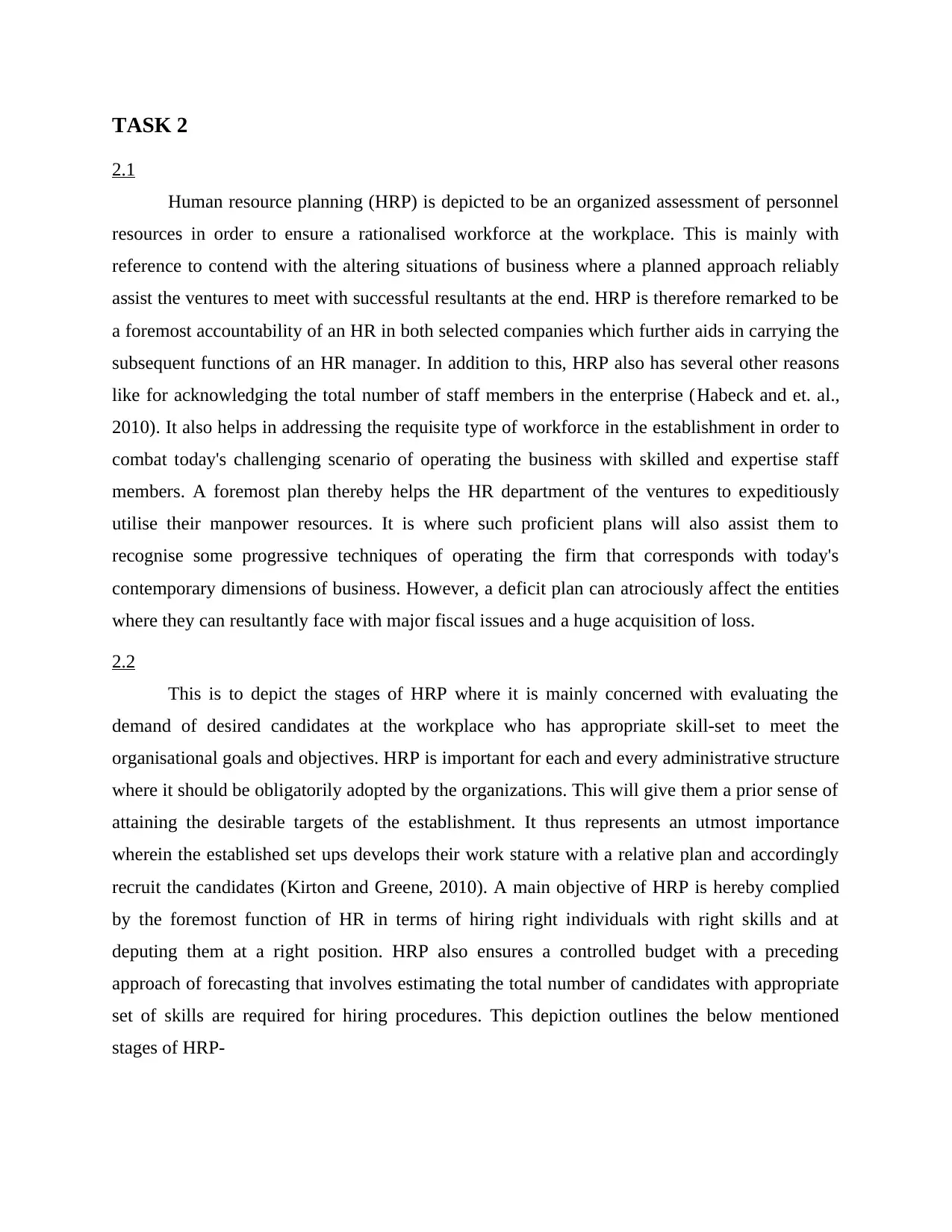
TASK 2
2.1
Human resource planning (HRP) is depicted to be an organized assessment of personnel
resources in order to ensure a rationalised workforce at the workplace. This is mainly with
reference to contend with the altering situations of business where a planned approach reliably
assist the ventures to meet with successful resultants at the end. HRP is therefore remarked to be
a foremost accountability of an HR in both selected companies which further aids in carrying the
subsequent functions of an HR manager. In addition to this, HRP also has several other reasons
like for acknowledging the total number of staff members in the enterprise (Habeck and et. al.,
2010). It also helps in addressing the requisite type of workforce in the establishment in order to
combat today's challenging scenario of operating the business with skilled and expertise staff
members. A foremost plan thereby helps the HR department of the ventures to expeditiously
utilise their manpower resources. It is where such proficient plans will also assist them to
recognise some progressive techniques of operating the firm that corresponds with today's
contemporary dimensions of business. However, a deficit plan can atrociously affect the entities
where they can resultantly face with major fiscal issues and a huge acquisition of loss.
2.2
This is to depict the stages of HRP where it is mainly concerned with evaluating the
demand of desired candidates at the workplace who has appropriate skill-set to meet the
organisational goals and objectives. HRP is important for each and every administrative structure
where it should be obligatorily adopted by the organizations. This will give them a prior sense of
attaining the desirable targets of the establishment. It thus represents an utmost importance
wherein the established set ups develops their work stature with a relative plan and accordingly
recruit the candidates (Kirton and Greene, 2010). A main objective of HRP is hereby complied
by the foremost function of HR in terms of hiring right individuals with right skills and at
deputing them at a right position. HRP also ensures a controlled budget with a preceding
approach of forecasting that involves estimating the total number of candidates with appropriate
set of skills are required for hiring procedures. This depiction outlines the below mentioned
stages of HRP-
2.1
Human resource planning (HRP) is depicted to be an organized assessment of personnel
resources in order to ensure a rationalised workforce at the workplace. This is mainly with
reference to contend with the altering situations of business where a planned approach reliably
assist the ventures to meet with successful resultants at the end. HRP is therefore remarked to be
a foremost accountability of an HR in both selected companies which further aids in carrying the
subsequent functions of an HR manager. In addition to this, HRP also has several other reasons
like for acknowledging the total number of staff members in the enterprise (Habeck and et. al.,
2010). It also helps in addressing the requisite type of workforce in the establishment in order to
combat today's challenging scenario of operating the business with skilled and expertise staff
members. A foremost plan thereby helps the HR department of the ventures to expeditiously
utilise their manpower resources. It is where such proficient plans will also assist them to
recognise some progressive techniques of operating the firm that corresponds with today's
contemporary dimensions of business. However, a deficit plan can atrociously affect the entities
where they can resultantly face with major fiscal issues and a huge acquisition of loss.
2.2
This is to depict the stages of HRP where it is mainly concerned with evaluating the
demand of desired candidates at the workplace who has appropriate skill-set to meet the
organisational goals and objectives. HRP is important for each and every administrative structure
where it should be obligatorily adopted by the organizations. This will give them a prior sense of
attaining the desirable targets of the establishment. It thus represents an utmost importance
wherein the established set ups develops their work stature with a relative plan and accordingly
recruit the candidates (Kirton and Greene, 2010). A main objective of HRP is hereby complied
by the foremost function of HR in terms of hiring right individuals with right skills and at
deputing them at a right position. HRP also ensures a controlled budget with a preceding
approach of forecasting that involves estimating the total number of candidates with appropriate
set of skills are required for hiring procedures. This depiction outlines the below mentioned
stages of HRP-
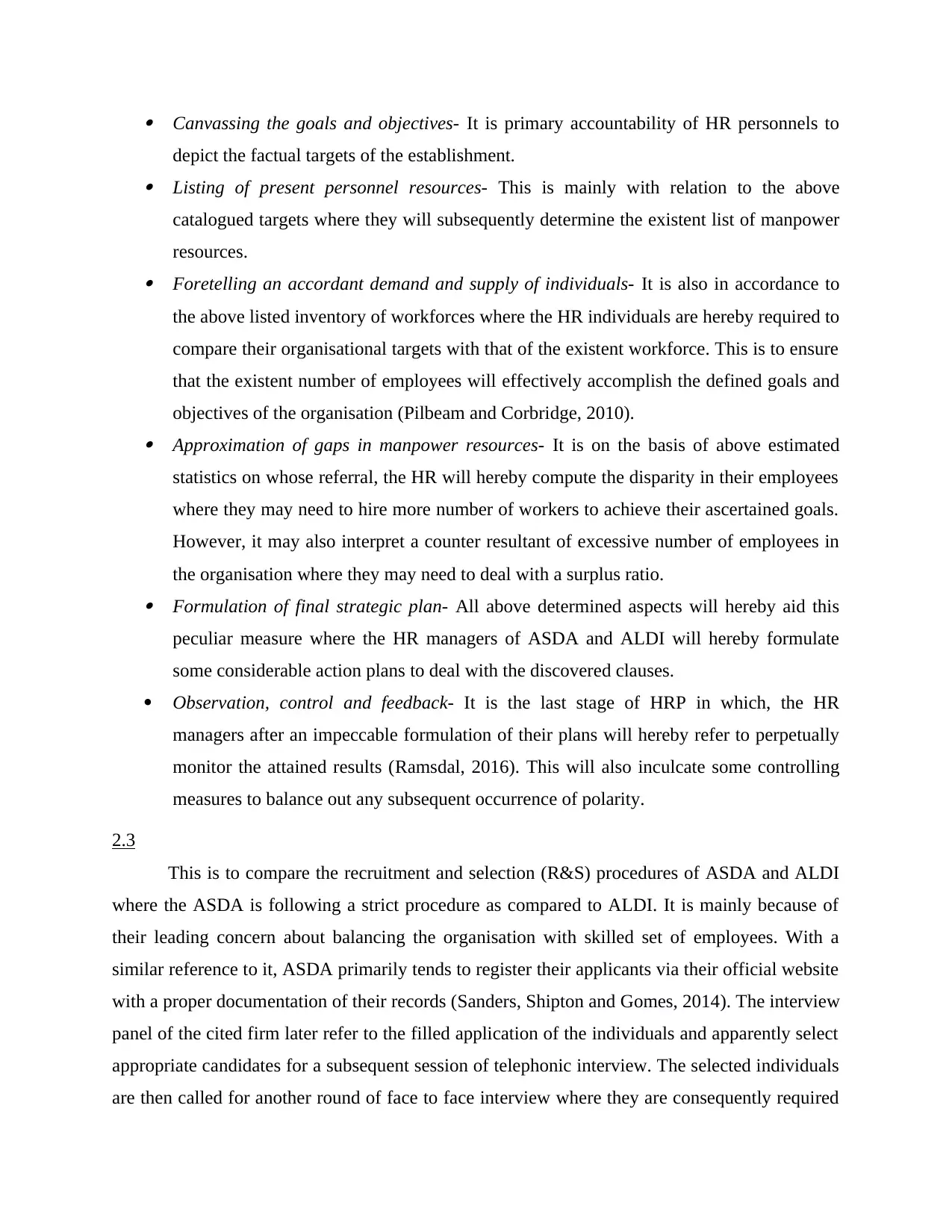
Canvassing the goals and objectives- It is primary accountability of HR personnels to
depict the factual targets of the establishment. Listing of present personnel resources- This is mainly with relation to the above
catalogued targets where they will subsequently determine the existent list of manpower
resources. Foretelling an accordant demand and supply of individuals- It is also in accordance to
the above listed inventory of workforces where the HR individuals are hereby required to
compare their organisational targets with that of the existent workforce. This is to ensure
that the existent number of employees will effectively accomplish the defined goals and
objectives of the organisation (Pilbeam and Corbridge, 2010). Approximation of gaps in manpower resources- It is on the basis of above estimated
statistics on whose referral, the HR will hereby compute the disparity in their employees
where they may need to hire more number of workers to achieve their ascertained goals.
However, it may also interpret a counter resultant of excessive number of employees in
the organisation where they may need to deal with a surplus ratio. Formulation of final strategic plan- All above determined aspects will hereby aid this
peculiar measure where the HR managers of ASDA and ALDI will hereby formulate
some considerable action plans to deal with the discovered clauses.
Observation, control and feedback- It is the last stage of HRP in which, the HR
managers after an impeccable formulation of their plans will hereby refer to perpetually
monitor the attained results (Ramsdal, 2016). This will also inculcate some controlling
measures to balance out any subsequent occurrence of polarity.
2.3
This is to compare the recruitment and selection (R&S) procedures of ASDA and ALDI
where the ASDA is following a strict procedure as compared to ALDI. It is mainly because of
their leading concern about balancing the organisation with skilled set of employees. With a
similar reference to it, ASDA primarily tends to register their applicants via their official website
with a proper documentation of their records (Sanders, Shipton and Gomes, 2014). The interview
panel of the cited firm later refer to the filled application of the individuals and apparently select
appropriate candidates for a subsequent session of telephonic interview. The selected individuals
are then called for another round of face to face interview where they are consequently required
depict the factual targets of the establishment. Listing of present personnel resources- This is mainly with relation to the above
catalogued targets where they will subsequently determine the existent list of manpower
resources. Foretelling an accordant demand and supply of individuals- It is also in accordance to
the above listed inventory of workforces where the HR individuals are hereby required to
compare their organisational targets with that of the existent workforce. This is to ensure
that the existent number of employees will effectively accomplish the defined goals and
objectives of the organisation (Pilbeam and Corbridge, 2010). Approximation of gaps in manpower resources- It is on the basis of above estimated
statistics on whose referral, the HR will hereby compute the disparity in their employees
where they may need to hire more number of workers to achieve their ascertained goals.
However, it may also interpret a counter resultant of excessive number of employees in
the organisation where they may need to deal with a surplus ratio. Formulation of final strategic plan- All above determined aspects will hereby aid this
peculiar measure where the HR managers of ASDA and ALDI will hereby formulate
some considerable action plans to deal with the discovered clauses.
Observation, control and feedback- It is the last stage of HRP in which, the HR
managers after an impeccable formulation of their plans will hereby refer to perpetually
monitor the attained results (Ramsdal, 2016). This will also inculcate some controlling
measures to balance out any subsequent occurrence of polarity.
2.3
This is to compare the recruitment and selection (R&S) procedures of ASDA and ALDI
where the ASDA is following a strict procedure as compared to ALDI. It is mainly because of
their leading concern about balancing the organisation with skilled set of employees. With a
similar reference to it, ASDA primarily tends to register their applicants via their official website
with a proper documentation of their records (Sanders, Shipton and Gomes, 2014). The interview
panel of the cited firm later refer to the filled application of the individuals and apparently select
appropriate candidates for a subsequent session of telephonic interview. The selected individuals
are then called for another round of face to face interview where they are consequently required
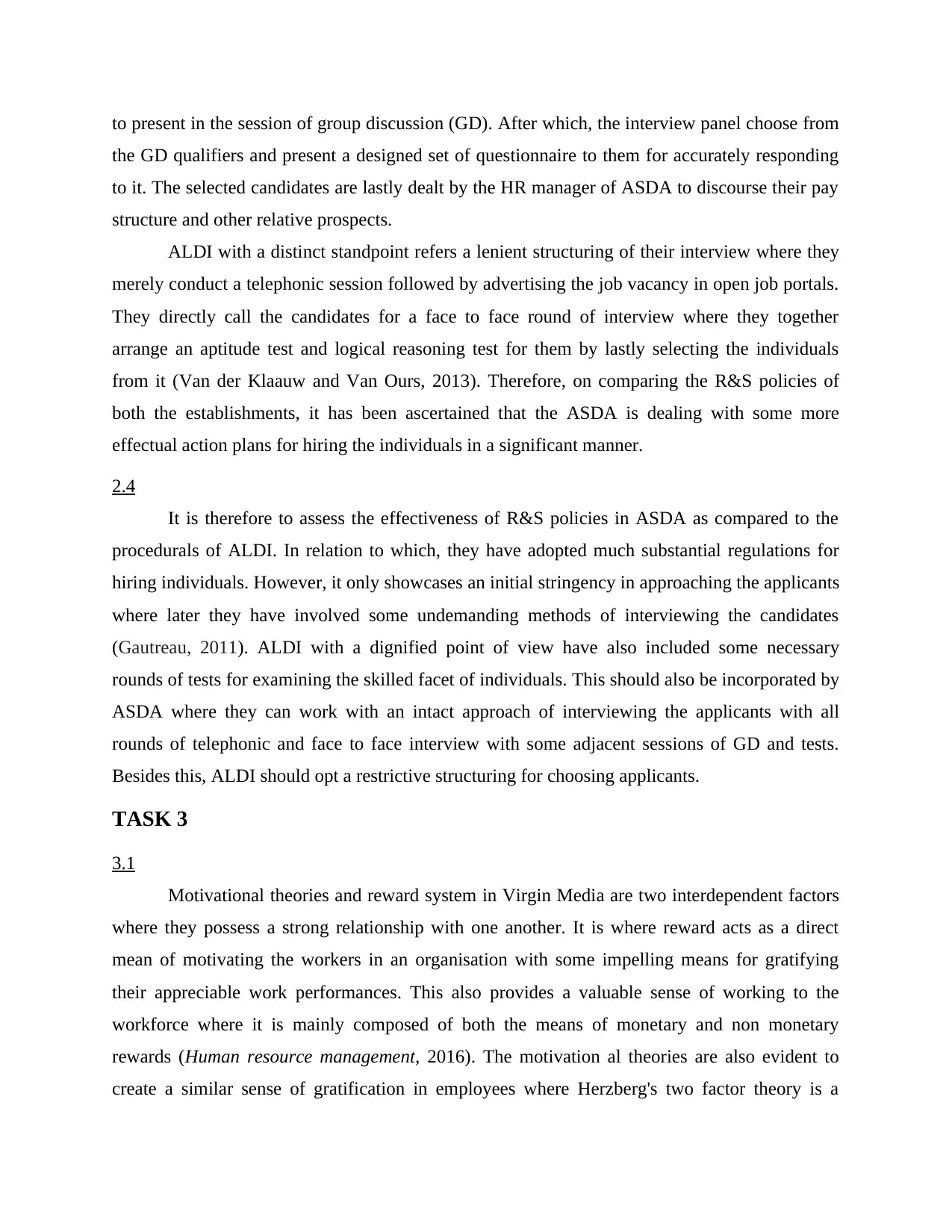
to present in the session of group discussion (GD). After which, the interview panel choose from
the GD qualifiers and present a designed set of questionnaire to them for accurately responding
to it. The selected candidates are lastly dealt by the HR manager of ASDA to discourse their pay
structure and other relative prospects.
ALDI with a distinct standpoint refers a lenient structuring of their interview where they
merely conduct a telephonic session followed by advertising the job vacancy in open job portals.
They directly call the candidates for a face to face round of interview where they together
arrange an aptitude test and logical reasoning test for them by lastly selecting the individuals
from it (Van der Klaauw and Van Ours, 2013). Therefore, on comparing the R&S policies of
both the establishments, it has been ascertained that the ASDA is dealing with some more
effectual action plans for hiring the individuals in a significant manner.
2.4
It is therefore to assess the effectiveness of R&S policies in ASDA as compared to the
procedurals of ALDI. In relation to which, they have adopted much substantial regulations for
hiring individuals. However, it only showcases an initial stringency in approaching the applicants
where later they have involved some undemanding methods of interviewing the candidates
(Gautreau, 2011). ALDI with a dignified point of view have also included some necessary
rounds of tests for examining the skilled facet of individuals. This should also be incorporated by
ASDA where they can work with an intact approach of interviewing the applicants with all
rounds of telephonic and face to face interview with some adjacent sessions of GD and tests.
Besides this, ALDI should opt a restrictive structuring for choosing applicants.
TASK 3
3.1
Motivational theories and reward system in Virgin Media are two interdependent factors
where they possess a strong relationship with one another. It is where reward acts as a direct
mean of motivating the workers in an organisation with some impelling means for gratifying
their appreciable work performances. This also provides a valuable sense of working to the
workforce where it is mainly composed of both the means of monetary and non monetary
rewards (Human resource management, 2016). The motivation al theories are also evident to
create a similar sense of gratification in employees where Herzberg's two factor theory is a
the GD qualifiers and present a designed set of questionnaire to them for accurately responding
to it. The selected candidates are lastly dealt by the HR manager of ASDA to discourse their pay
structure and other relative prospects.
ALDI with a distinct standpoint refers a lenient structuring of their interview where they
merely conduct a telephonic session followed by advertising the job vacancy in open job portals.
They directly call the candidates for a face to face round of interview where they together
arrange an aptitude test and logical reasoning test for them by lastly selecting the individuals
from it (Van der Klaauw and Van Ours, 2013). Therefore, on comparing the R&S policies of
both the establishments, it has been ascertained that the ASDA is dealing with some more
effectual action plans for hiring the individuals in a significant manner.
2.4
It is therefore to assess the effectiveness of R&S policies in ASDA as compared to the
procedurals of ALDI. In relation to which, they have adopted much substantial regulations for
hiring individuals. However, it only showcases an initial stringency in approaching the applicants
where later they have involved some undemanding methods of interviewing the candidates
(Gautreau, 2011). ALDI with a dignified point of view have also included some necessary
rounds of tests for examining the skilled facet of individuals. This should also be incorporated by
ASDA where they can work with an intact approach of interviewing the applicants with all
rounds of telephonic and face to face interview with some adjacent sessions of GD and tests.
Besides this, ALDI should opt a restrictive structuring for choosing applicants.
TASK 3
3.1
Motivational theories and reward system in Virgin Media are two interdependent factors
where they possess a strong relationship with one another. It is where reward acts as a direct
mean of motivating the workers in an organisation with some impelling means for gratifying
their appreciable work performances. This also provides a valuable sense of working to the
workforce where it is mainly composed of both the means of monetary and non monetary
rewards (Human resource management, 2016). The motivation al theories are also evident to
create a similar sense of gratification in employees where Herzberg's two factor theory is a
Paraphrase This Document
Need a fresh take? Get an instant paraphrase of this document with our AI Paraphraser
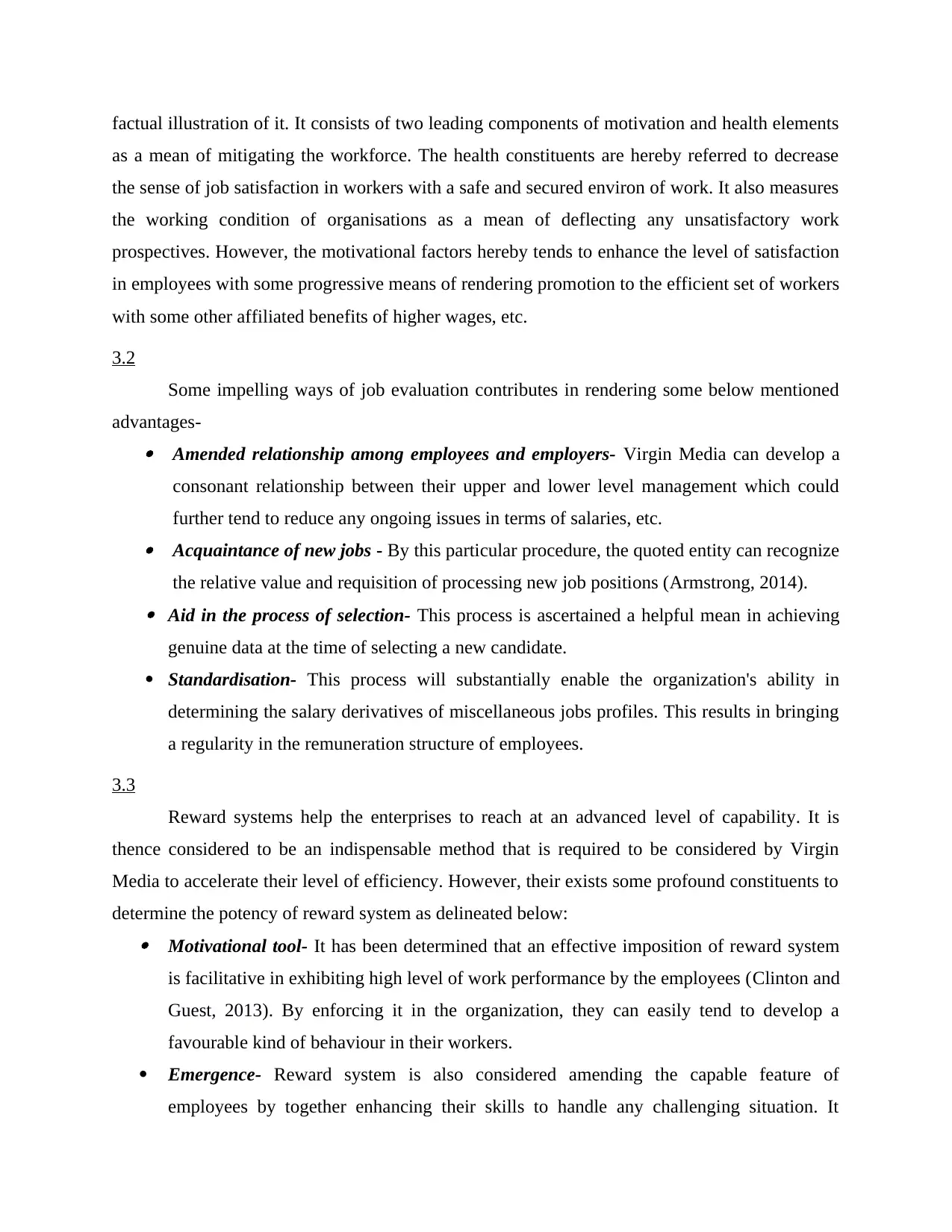
factual illustration of it. It consists of two leading components of motivation and health elements
as a mean of mitigating the workforce. The health constituents are hereby referred to decrease
the sense of job satisfaction in workers with a safe and secured environ of work. It also measures
the working condition of organisations as a mean of deflecting any unsatisfactory work
prospectives. However, the motivational factors hereby tends to enhance the level of satisfaction
in employees with some progressive means of rendering promotion to the efficient set of workers
with some other affiliated benefits of higher wages, etc.
3.2
Some impelling ways of job evaluation contributes in rendering some below mentioned
advantages- Amended relationship among employees and employers- Virgin Media can develop a
consonant relationship between their upper and lower level management which could
further tend to reduce any ongoing issues in terms of salaries, etc. Acquaintance of new jobs - By this particular procedure, the quoted entity can recognize
the relative value and requisition of processing new job positions (Armstrong, 2014). Aid in the process of selection- This process is ascertained a helpful mean in achieving
genuine data at the time of selecting a new candidate.
Standardisation- This process will substantially enable the organization's ability in
determining the salary derivatives of miscellaneous jobs profiles. This results in bringing
a regularity in the remuneration structure of employees.
3.3
Reward systems help the enterprises to reach at an advanced level of capability. It is
thence considered to be an indispensable method that is required to be considered by Virgin
Media to accelerate their level of efficiency. However, their exists some profound constituents to
determine the potency of reward system as delineated below: Motivational tool- It has been determined that an effective imposition of reward system
is facilitative in exhibiting high level of work performance by the employees (Clinton and
Guest, 2013). By enforcing it in the organization, they can easily tend to develop a
favourable kind of behaviour in their workers.
Emergence- Reward system is also considered amending the capable feature of
employees by together enhancing their skills to handle any challenging situation. It
as a mean of mitigating the workforce. The health constituents are hereby referred to decrease
the sense of job satisfaction in workers with a safe and secured environ of work. It also measures
the working condition of organisations as a mean of deflecting any unsatisfactory work
prospectives. However, the motivational factors hereby tends to enhance the level of satisfaction
in employees with some progressive means of rendering promotion to the efficient set of workers
with some other affiliated benefits of higher wages, etc.
3.2
Some impelling ways of job evaluation contributes in rendering some below mentioned
advantages- Amended relationship among employees and employers- Virgin Media can develop a
consonant relationship between their upper and lower level management which could
further tend to reduce any ongoing issues in terms of salaries, etc. Acquaintance of new jobs - By this particular procedure, the quoted entity can recognize
the relative value and requisition of processing new job positions (Armstrong, 2014). Aid in the process of selection- This process is ascertained a helpful mean in achieving
genuine data at the time of selecting a new candidate.
Standardisation- This process will substantially enable the organization's ability in
determining the salary derivatives of miscellaneous jobs profiles. This results in bringing
a regularity in the remuneration structure of employees.
3.3
Reward systems help the enterprises to reach at an advanced level of capability. It is
thence considered to be an indispensable method that is required to be considered by Virgin
Media to accelerate their level of efficiency. However, their exists some profound constituents to
determine the potency of reward system as delineated below: Motivational tool- It has been determined that an effective imposition of reward system
is facilitative in exhibiting high level of work performance by the employees (Clinton and
Guest, 2013). By enforcing it in the organization, they can easily tend to develop a
favourable kind of behaviour in their workers.
Emergence- Reward system is also considered amending the capable feature of
employees by together enhancing their skills to handle any challenging situation. It
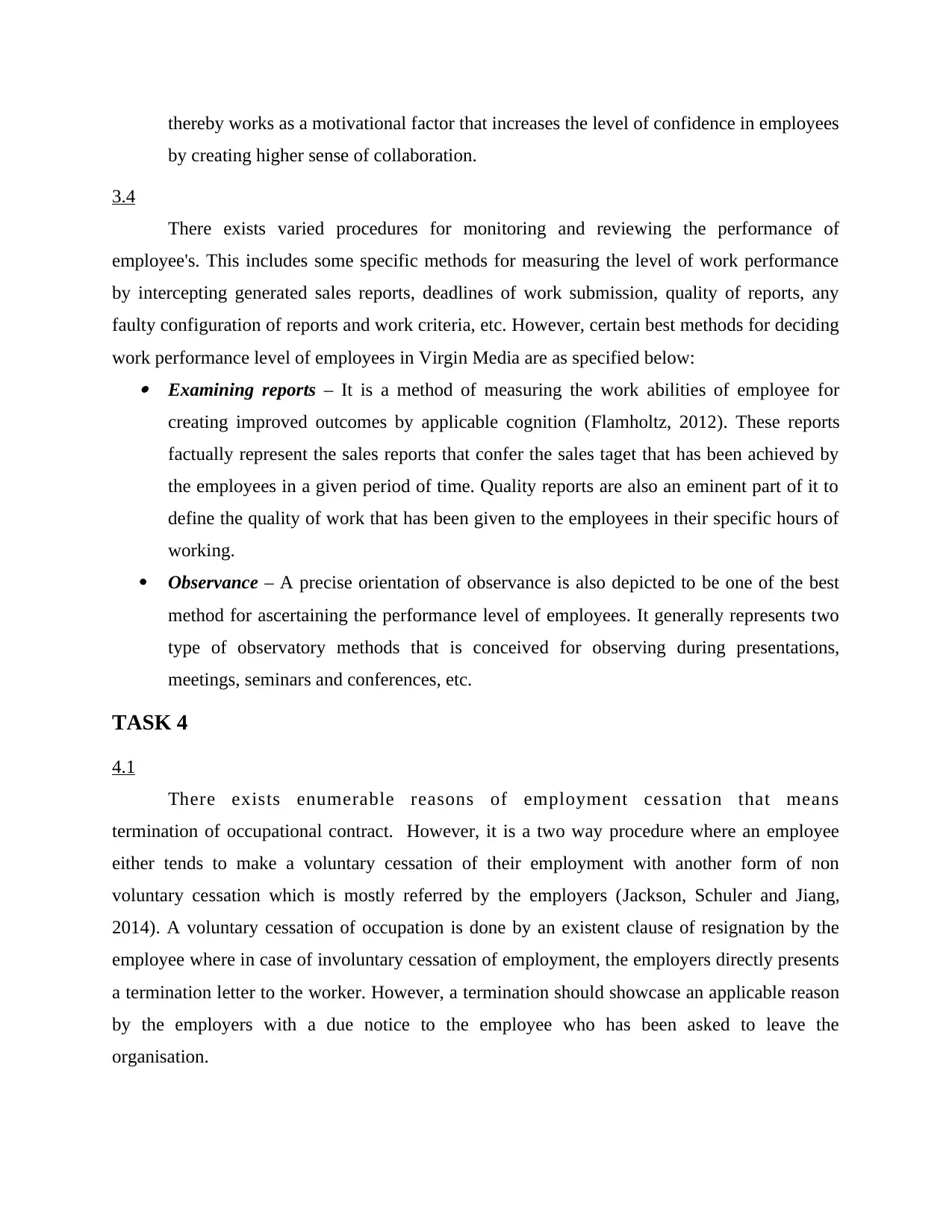
thereby works as a motivational factor that increases the level of confidence in employees
by creating higher sense of collaboration.
3.4
There exists varied procedures for monitoring and reviewing the performance of
employee's. This includes some specific methods for measuring the level of work performance
by intercepting generated sales reports, deadlines of work submission, quality of reports, any
faulty configuration of reports and work criteria, etc. However, certain best methods for deciding
work performance level of employees in Virgin Media are as specified below: Examining reports – It is a method of measuring the work abilities of employee for
creating improved outcomes by applicable cognition (Flamholtz, 2012). These reports
factually represent the sales reports that confer the sales taget that has been achieved by
the employees in a given period of time. Quality reports are also an eminent part of it to
define the quality of work that has been given to the employees in their specific hours of
working.
Observance – A precise orientation of observance is also depicted to be one of the best
method for ascertaining the performance level of employees. It generally represents two
type of observatory methods that is conceived for observing during presentations,
meetings, seminars and conferences, etc.
TASK 4
4.1
There exists enumerable reasons of employment cessation that means
termination of occupational contract. However, it is a two way procedure where an employee
either tends to make a voluntary cessation of their employment with another form of non
voluntary cessation which is mostly referred by the employers (Jackson, Schuler and Jiang,
2014). A voluntary cessation of occupation is done by an existent clause of resignation by the
employee where in case of involuntary cessation of employment, the employers directly presents
a termination letter to the worker. However, a termination should showcase an applicable reason
by the employers with a due notice to the employee who has been asked to leave the
organisation.
by creating higher sense of collaboration.
3.4
There exists varied procedures for monitoring and reviewing the performance of
employee's. This includes some specific methods for measuring the level of work performance
by intercepting generated sales reports, deadlines of work submission, quality of reports, any
faulty configuration of reports and work criteria, etc. However, certain best methods for deciding
work performance level of employees in Virgin Media are as specified below: Examining reports – It is a method of measuring the work abilities of employee for
creating improved outcomes by applicable cognition (Flamholtz, 2012). These reports
factually represent the sales reports that confer the sales taget that has been achieved by
the employees in a given period of time. Quality reports are also an eminent part of it to
define the quality of work that has been given to the employees in their specific hours of
working.
Observance – A precise orientation of observance is also depicted to be one of the best
method for ascertaining the performance level of employees. It generally represents two
type of observatory methods that is conceived for observing during presentations,
meetings, seminars and conferences, etc.
TASK 4
4.1
There exists enumerable reasons of employment cessation that means
termination of occupational contract. However, it is a two way procedure where an employee
either tends to make a voluntary cessation of their employment with another form of non
voluntary cessation which is mostly referred by the employers (Jackson, Schuler and Jiang,
2014). A voluntary cessation of occupation is done by an existent clause of resignation by the
employee where in case of involuntary cessation of employment, the employers directly presents
a termination letter to the worker. However, a termination should showcase an applicable reason
by the employers with a due notice to the employee who has been asked to leave the
organisation.
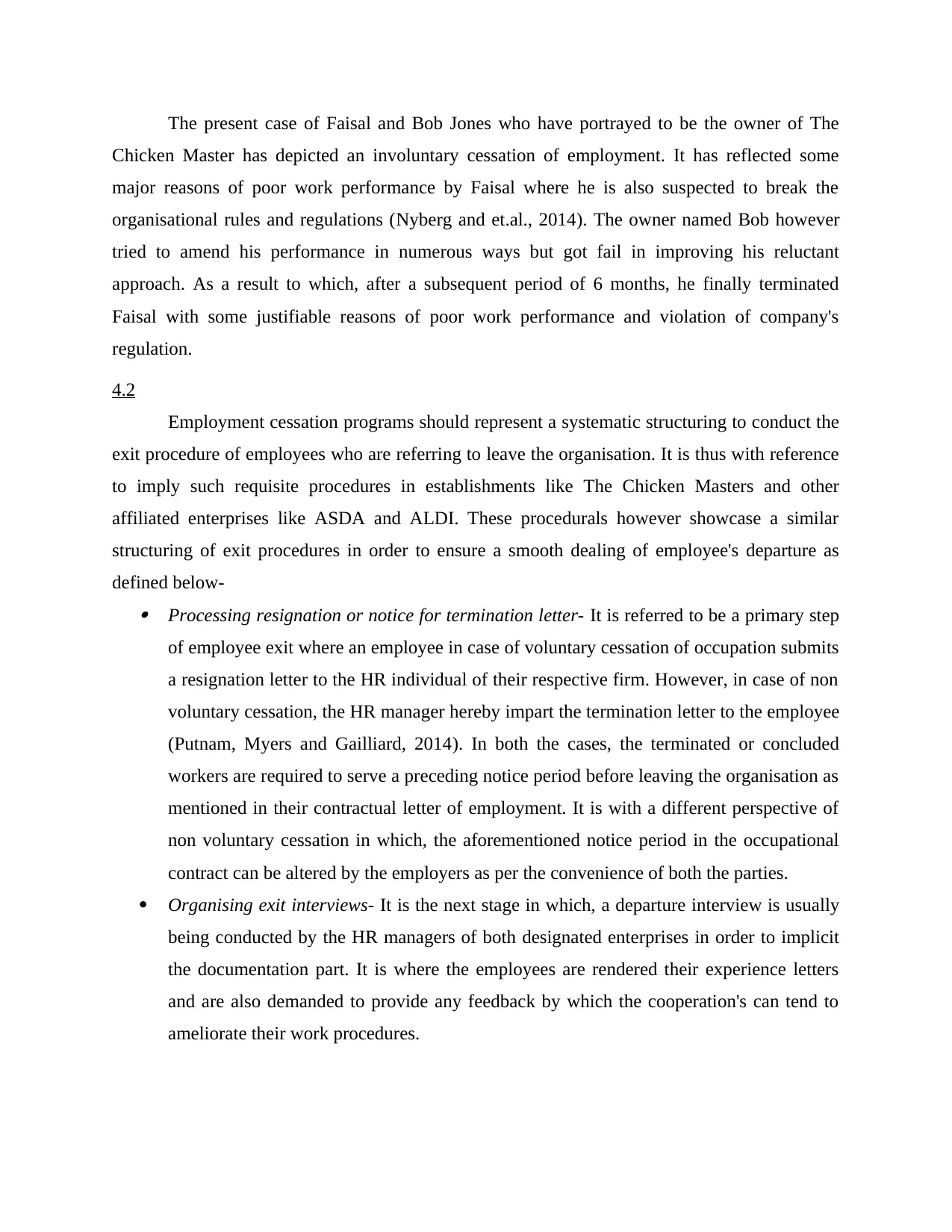
The present case of Faisal and Bob Jones who have portrayed to be the owner of The
Chicken Master has depicted an involuntary cessation of employment. It has reflected some
major reasons of poor work performance by Faisal where he is also suspected to break the
organisational rules and regulations (Nyberg and et.al., 2014). The owner named Bob however
tried to amend his performance in numerous ways but got fail in improving his reluctant
approach. As a result to which, after a subsequent period of 6 months, he finally terminated
Faisal with some justifiable reasons of poor work performance and violation of company's
regulation.
4.2
Employment cessation programs should represent a systematic structuring to conduct the
exit procedure of employees who are referring to leave the organisation. It is thus with reference
to imply such requisite procedures in establishments like The Chicken Masters and other
affiliated enterprises like ASDA and ALDI. These procedurals however showcase a similar
structuring of exit procedures in order to ensure a smooth dealing of employee's departure as
defined below- Processing resignation or notice for termination letter- It is referred to be a primary step
of employee exit where an employee in case of voluntary cessation of occupation submits
a resignation letter to the HR individual of their respective firm. However, in case of non
voluntary cessation, the HR manager hereby impart the termination letter to the employee
(Putnam, Myers and Gailliard, 2014). In both the cases, the terminated or concluded
workers are required to serve a preceding notice period before leaving the organisation as
mentioned in their contractual letter of employment. It is with a different perspective of
non voluntary cessation in which, the aforementioned notice period in the occupational
contract can be altered by the employers as per the convenience of both the parties.
Organising exit interviews- It is the next stage in which, a departure interview is usually
being conducted by the HR managers of both designated enterprises in order to implicit
the documentation part. It is where the employees are rendered their experience letters
and are also demanded to provide any feedback by which the cooperation's can tend to
ameliorate their work procedures.
Chicken Master has depicted an involuntary cessation of employment. It has reflected some
major reasons of poor work performance by Faisal where he is also suspected to break the
organisational rules and regulations (Nyberg and et.al., 2014). The owner named Bob however
tried to amend his performance in numerous ways but got fail in improving his reluctant
approach. As a result to which, after a subsequent period of 6 months, he finally terminated
Faisal with some justifiable reasons of poor work performance and violation of company's
regulation.
4.2
Employment cessation programs should represent a systematic structuring to conduct the
exit procedure of employees who are referring to leave the organisation. It is thus with reference
to imply such requisite procedures in establishments like The Chicken Masters and other
affiliated enterprises like ASDA and ALDI. These procedurals however showcase a similar
structuring of exit procedures in order to ensure a smooth dealing of employee's departure as
defined below- Processing resignation or notice for termination letter- It is referred to be a primary step
of employee exit where an employee in case of voluntary cessation of occupation submits
a resignation letter to the HR individual of their respective firm. However, in case of non
voluntary cessation, the HR manager hereby impart the termination letter to the employee
(Putnam, Myers and Gailliard, 2014). In both the cases, the terminated or concluded
workers are required to serve a preceding notice period before leaving the organisation as
mentioned in their contractual letter of employment. It is with a different perspective of
non voluntary cessation in which, the aforementioned notice period in the occupational
contract can be altered by the employers as per the convenience of both the parties.
Organising exit interviews- It is the next stage in which, a departure interview is usually
being conducted by the HR managers of both designated enterprises in order to implicit
the documentation part. It is where the employees are rendered their experience letters
and are also demanded to provide any feedback by which the cooperation's can tend to
ameliorate their work procedures.
Secure Best Marks with AI Grader
Need help grading? Try our AI Grader for instant feedback on your assignments.
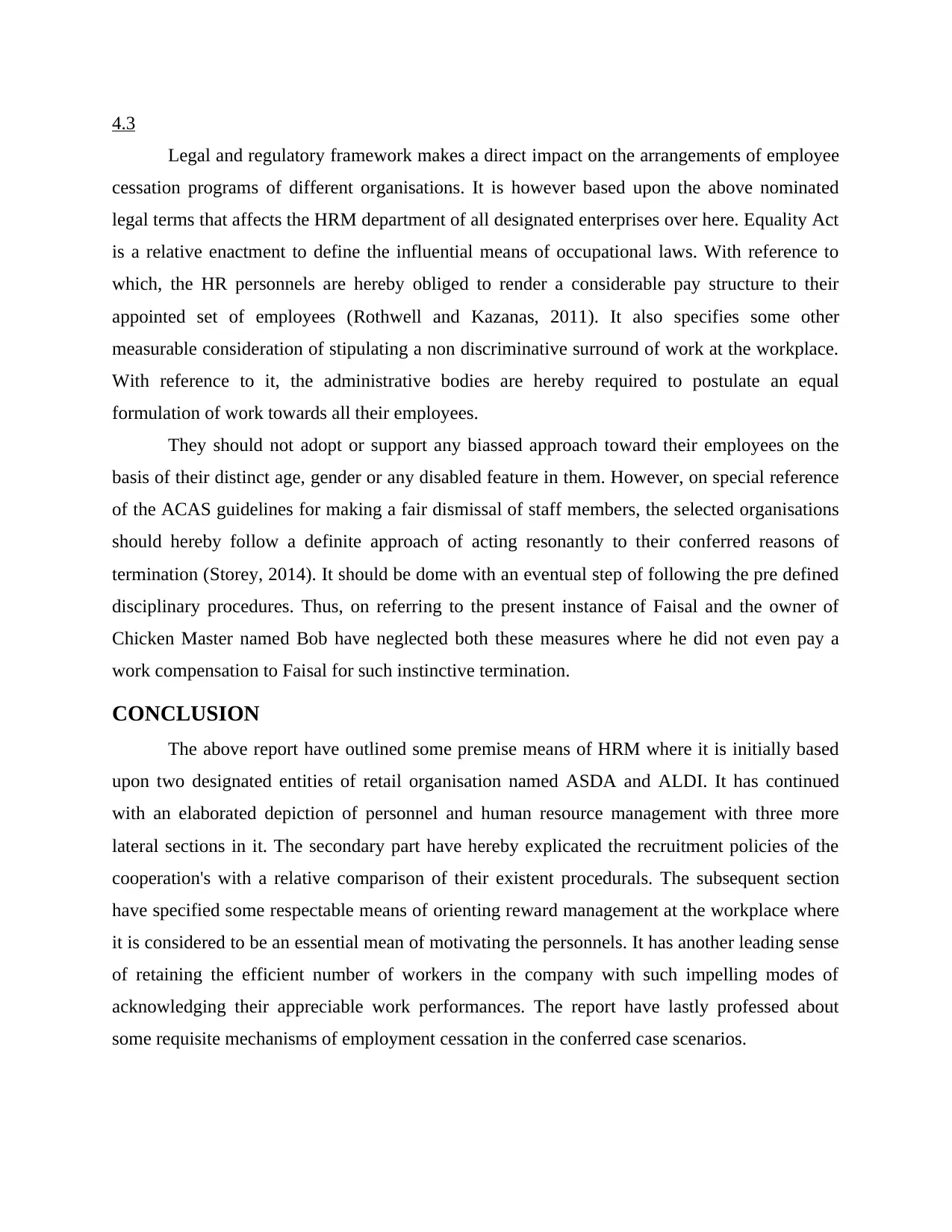
4.3
Legal and regulatory framework makes a direct impact on the arrangements of employee
cessation programs of different organisations. It is however based upon the above nominated
legal terms that affects the HRM department of all designated enterprises over here. Equality Act
is a relative enactment to define the influential means of occupational laws. With reference to
which, the HR personnels are hereby obliged to render a considerable pay structure to their
appointed set of employees (Rothwell and Kazanas, 2011). It also specifies some other
measurable consideration of stipulating a non discriminative surround of work at the workplace.
With reference to it, the administrative bodies are hereby required to postulate an equal
formulation of work towards all their employees.
They should not adopt or support any biassed approach toward their employees on the
basis of their distinct age, gender or any disabled feature in them. However, on special reference
of the ACAS guidelines for making a fair dismissal of staff members, the selected organisations
should hereby follow a definite approach of acting resonantly to their conferred reasons of
termination (Storey, 2014). It should be dome with an eventual step of following the pre defined
disciplinary procedures. Thus, on referring to the present instance of Faisal and the owner of
Chicken Master named Bob have neglected both these measures where he did not even pay a
work compensation to Faisal for such instinctive termination.
CONCLUSION
The above report have outlined some premise means of HRM where it is initially based
upon two designated entities of retail organisation named ASDA and ALDI. It has continued
with an elaborated depiction of personnel and human resource management with three more
lateral sections in it. The secondary part have hereby explicated the recruitment policies of the
cooperation's with a relative comparison of their existent procedurals. The subsequent section
have specified some respectable means of orienting reward management at the workplace where
it is considered to be an essential mean of motivating the personnels. It has another leading sense
of retaining the efficient number of workers in the company with such impelling modes of
acknowledging their appreciable work performances. The report have lastly professed about
some requisite mechanisms of employment cessation in the conferred case scenarios.
Legal and regulatory framework makes a direct impact on the arrangements of employee
cessation programs of different organisations. It is however based upon the above nominated
legal terms that affects the HRM department of all designated enterprises over here. Equality Act
is a relative enactment to define the influential means of occupational laws. With reference to
which, the HR personnels are hereby obliged to render a considerable pay structure to their
appointed set of employees (Rothwell and Kazanas, 2011). It also specifies some other
measurable consideration of stipulating a non discriminative surround of work at the workplace.
With reference to it, the administrative bodies are hereby required to postulate an equal
formulation of work towards all their employees.
They should not adopt or support any biassed approach toward their employees on the
basis of their distinct age, gender or any disabled feature in them. However, on special reference
of the ACAS guidelines for making a fair dismissal of staff members, the selected organisations
should hereby follow a definite approach of acting resonantly to their conferred reasons of
termination (Storey, 2014). It should be dome with an eventual step of following the pre defined
disciplinary procedures. Thus, on referring to the present instance of Faisal and the owner of
Chicken Master named Bob have neglected both these measures where he did not even pay a
work compensation to Faisal for such instinctive termination.
CONCLUSION
The above report have outlined some premise means of HRM where it is initially based
upon two designated entities of retail organisation named ASDA and ALDI. It has continued
with an elaborated depiction of personnel and human resource management with three more
lateral sections in it. The secondary part have hereby explicated the recruitment policies of the
cooperation's with a relative comparison of their existent procedurals. The subsequent section
have specified some respectable means of orienting reward management at the workplace where
it is considered to be an essential mean of motivating the personnels. It has another leading sense
of retaining the efficient number of workers in the company with such impelling modes of
acknowledging their appreciable work performances. The report have lastly professed about
some requisite mechanisms of employment cessation in the conferred case scenarios.
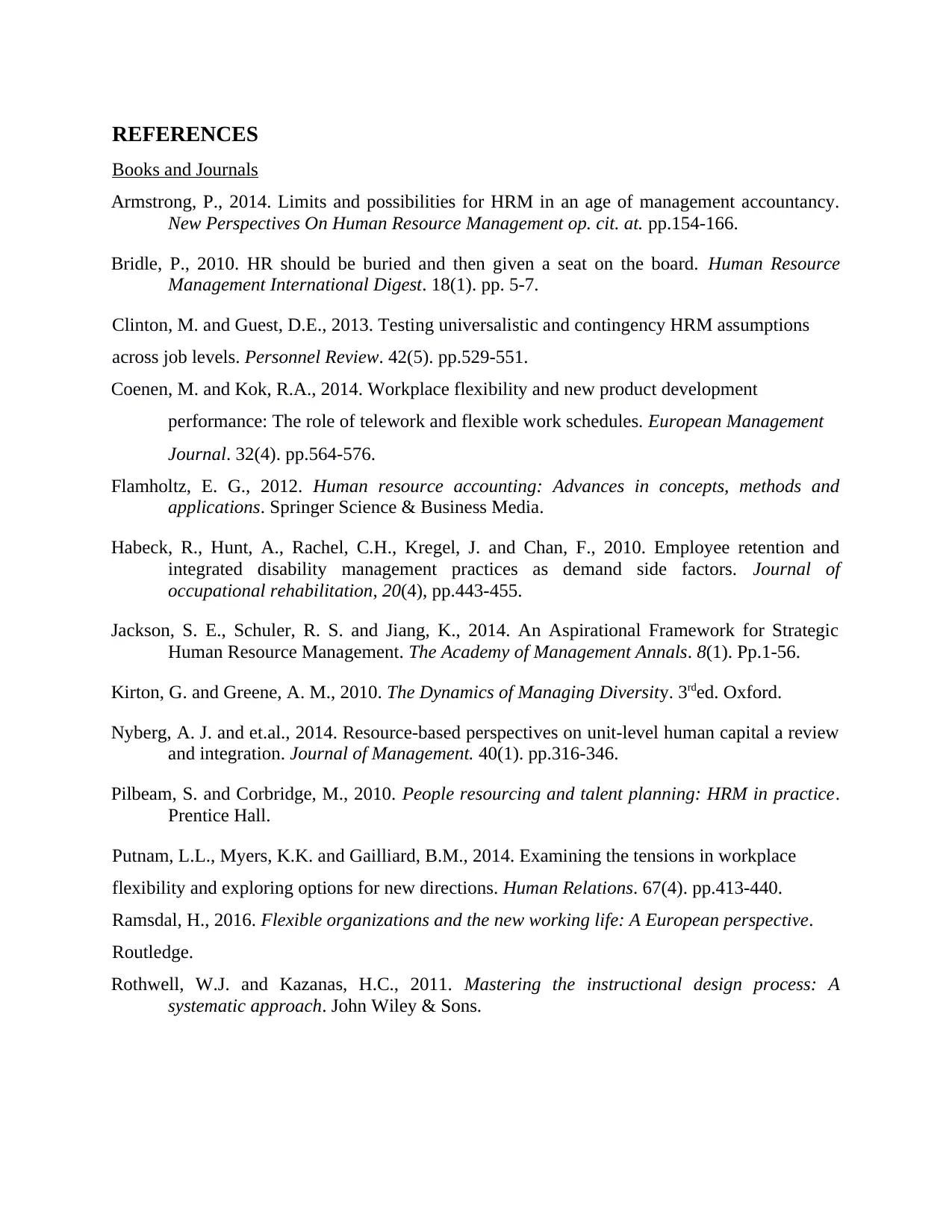
REFERENCES
Books and Journals
Armstrong, P., 2014. Limits and possibilities for HRM in an age of management accountancy.
New Perspectives On Human Resource Management op. cit. at. pp.154-166.
Bridle, P., 2010. HR should be buried and then given a seat on the board. Human Resource
Management International Digest. 18(1). pp. 5-7.
Clinton, M. and Guest, D.E., 2013. Testing universalistic and contingency HRM assumptions
across job levels. Personnel Review. 42(5). pp.529-551.
Coenen, M. and Kok, R.A., 2014. Workplace flexibility and new product development
performance: The role of telework and flexible work schedules. European Management
Journal. 32(4). pp.564-576.
Flamholtz, E. G., 2012. Human resource accounting: Advances in concepts, methods and
applications. Springer Science & Business Media.
Habeck, R., Hunt, A., Rachel, C.H., Kregel, J. and Chan, F., 2010. Employee retention and
integrated disability management practices as demand side factors. Journal of
occupational rehabilitation, 20(4), pp.443-455.
Jackson, S. E., Schuler, R. S. and Jiang, K., 2014. An Aspirational Framework for Strategic
Human Resource Management. The Academy of Management Annals. 8(1). Pp.1-56.
Kirton, G. and Greene, A. M., 2010. The Dynamics of Managing Diversity. 3rded. Oxford.
Nyberg, A. J. and et.al., 2014. Resource-based perspectives on unit-level human capital a review
and integration. Journal of Management. 40(1). pp.316-346.
Pilbeam, S. and Corbridge, M., 2010. People resourcing and talent planning: HRM in practice.
Prentice Hall.
Putnam, L.L., Myers, K.K. and Gailliard, B.M., 2014. Examining the tensions in workplace
flexibility and exploring options for new directions. Human Relations. 67(4). pp.413-440.
Ramsdal, H., 2016. Flexible organizations and the new working life: A European perspective.
Routledge.
Rothwell, W.J. and Kazanas, H.C., 2011. Mastering the instructional design process: A
systematic approach. John Wiley & Sons.
Books and Journals
Armstrong, P., 2014. Limits and possibilities for HRM in an age of management accountancy.
New Perspectives On Human Resource Management op. cit. at. pp.154-166.
Bridle, P., 2010. HR should be buried and then given a seat on the board. Human Resource
Management International Digest. 18(1). pp. 5-7.
Clinton, M. and Guest, D.E., 2013. Testing universalistic and contingency HRM assumptions
across job levels. Personnel Review. 42(5). pp.529-551.
Coenen, M. and Kok, R.A., 2014. Workplace flexibility and new product development
performance: The role of telework and flexible work schedules. European Management
Journal. 32(4). pp.564-576.
Flamholtz, E. G., 2012. Human resource accounting: Advances in concepts, methods and
applications. Springer Science & Business Media.
Habeck, R., Hunt, A., Rachel, C.H., Kregel, J. and Chan, F., 2010. Employee retention and
integrated disability management practices as demand side factors. Journal of
occupational rehabilitation, 20(4), pp.443-455.
Jackson, S. E., Schuler, R. S. and Jiang, K., 2014. An Aspirational Framework for Strategic
Human Resource Management. The Academy of Management Annals. 8(1). Pp.1-56.
Kirton, G. and Greene, A. M., 2010. The Dynamics of Managing Diversity. 3rded. Oxford.
Nyberg, A. J. and et.al., 2014. Resource-based perspectives on unit-level human capital a review
and integration. Journal of Management. 40(1). pp.316-346.
Pilbeam, S. and Corbridge, M., 2010. People resourcing and talent planning: HRM in practice.
Prentice Hall.
Putnam, L.L., Myers, K.K. and Gailliard, B.M., 2014. Examining the tensions in workplace
flexibility and exploring options for new directions. Human Relations. 67(4). pp.413-440.
Ramsdal, H., 2016. Flexible organizations and the new working life: A European perspective.
Routledge.
Rothwell, W.J. and Kazanas, H.C., 2011. Mastering the instructional design process: A
systematic approach. John Wiley & Sons.
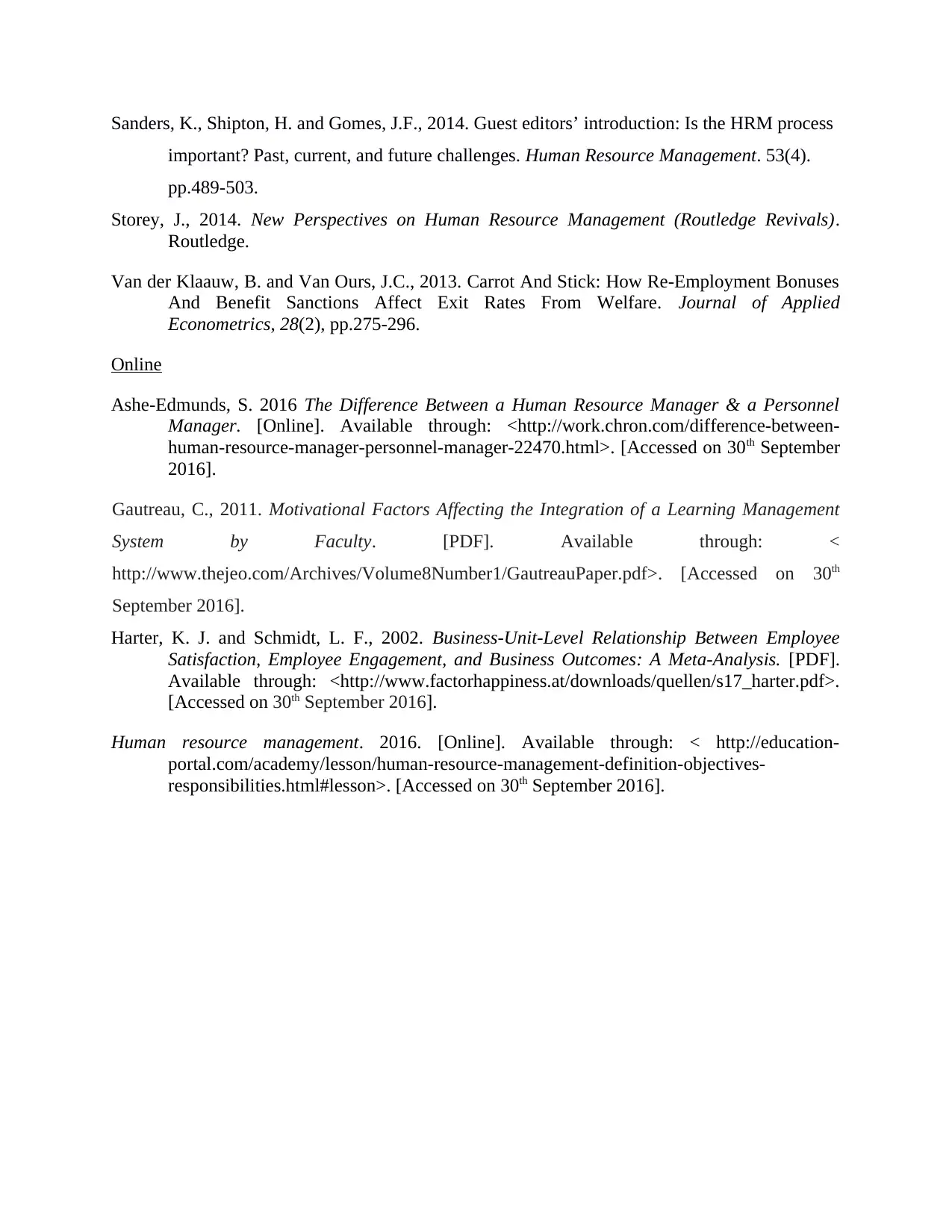
Sanders, K., Shipton, H. and Gomes, J.F., 2014. Guest editors’ introduction: Is the HRM process
important? Past, current, and future challenges. Human Resource Management. 53(4).
pp.489-503.
Storey, J., 2014. New Perspectives on Human Resource Management (Routledge Revivals).
Routledge.
Van der Klaauw, B. and Van Ours, J.C., 2013. Carrot And Stick: How Re‐Employment Bonuses
And Benefit Sanctions Affect Exit Rates From Welfare. Journal of Applied
Econometrics, 28(2), pp.275-296.
Online
Ashe-Edmunds, S. 2016 The Difference Between a Human Resource Manager & a Personnel
Manager. [Online]. Available through: <http://work.chron.com/difference-between-
human-resource-manager-personnel-manager-22470.html>. [Accessed on 30th September
2016].
Gautreau, C., 2011. Motivational Factors Affecting the Integration of a Learning Management
System by Faculty. [PDF]. Available through: <
http://www.thejeo.com/Archives/Volume8Number1/GautreauPaper.pdf>. [Accessed on 30th
September 2016].
Harter, K. J. and Schmidt, L. F., 2002. Business-Unit-Level Relationship Between Employee
Satisfaction, Employee Engagement, and Business Outcomes: A Meta-Analysis. [PDF].
Available through: <http://www.factorhappiness.at/downloads/quellen/s17_harter.pdf>.
[Accessed on 30th September 2016].
Human resource management. 2016. [Online]. Available through: < http://education-
portal.com/academy/lesson/human-resource-management-definition-objectives-
responsibilities.html#lesson>. [Accessed on 30th September 2016].
important? Past, current, and future challenges. Human Resource Management. 53(4).
pp.489-503.
Storey, J., 2014. New Perspectives on Human Resource Management (Routledge Revivals).
Routledge.
Van der Klaauw, B. and Van Ours, J.C., 2013. Carrot And Stick: How Re‐Employment Bonuses
And Benefit Sanctions Affect Exit Rates From Welfare. Journal of Applied
Econometrics, 28(2), pp.275-296.
Online
Ashe-Edmunds, S. 2016 The Difference Between a Human Resource Manager & a Personnel
Manager. [Online]. Available through: <http://work.chron.com/difference-between-
human-resource-manager-personnel-manager-22470.html>. [Accessed on 30th September
2016].
Gautreau, C., 2011. Motivational Factors Affecting the Integration of a Learning Management
System by Faculty. [PDF]. Available through: <
http://www.thejeo.com/Archives/Volume8Number1/GautreauPaper.pdf>. [Accessed on 30th
September 2016].
Harter, K. J. and Schmidt, L. F., 2002. Business-Unit-Level Relationship Between Employee
Satisfaction, Employee Engagement, and Business Outcomes: A Meta-Analysis. [PDF].
Available through: <http://www.factorhappiness.at/downloads/quellen/s17_harter.pdf>.
[Accessed on 30th September 2016].
Human resource management. 2016. [Online]. Available through: < http://education-
portal.com/academy/lesson/human-resource-management-definition-objectives-
responsibilities.html#lesson>. [Accessed on 30th September 2016].
1 out of 16
![[object Object]](/_next/static/media/star-bottom.7253800d.svg)





